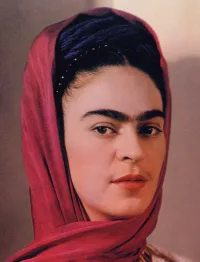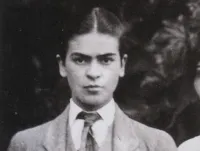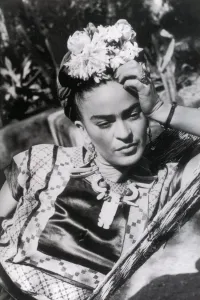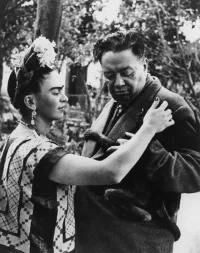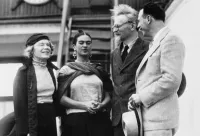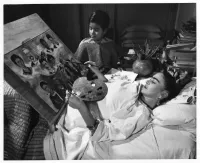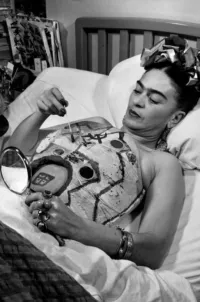Biography
1907 - 1954
“Nothing is worth more than laughter. It is strength to laugh and to abandon oneself, to be light. Tragedy is the most ridiculous thing.”
- Frida Kahlo
As a child Frida Kahlo was deeply affected by the armed struggles she witnessed on the streets of Mexico City; so much so that later in her life she would claim 1910 – the official start of the Mexican Revolution – as the year of her birth. Kahlo contracted polio at age six and suffered from spina bifida. Plagued with health problems throughout her life, she sustained horrifying injuries when a bus she was riding in collided with a trolley car. After the accident confined her to a full-body cast, Kahlo began to paint. Her work – characterized by its stark portrayal of both psychological and physical pain – incorporated 19th-Century Mexican portraiture, elements of Mexican pop culture and pre-Columbian iconography, and was often done on sheet metal rather than canvas. Nearly one-third of her paintings are self-portraits for, as Kahlo once said, “I paint myself because I am so often alone and because I am the subject I know best." Against her mother’s wishes, in 1929 Kahlo began a tempestuous marriage to Mexican painter, Diego Rivera, who recognized her talent early on, though for much of her career she would remain in his shadow. Defying convention, she flaunted numerous extramarital affairs – relationships complicated by Rivera’s own friendships with some of her paramours, most notably Leon Trotsky, Josephine Baker, and artists Isamu Noguchi and Georgia O’Keeffe. By the 1950’s her health issues became nearly all-consuming – culminating with the amputation of her right leg in 1953. During her hospitalization she contracted bronchial pneumonia and died a week after her forty-seventh birthday from a pulmonary embolism. Kahlo’s idiosyncratic work was not widely recognized until decades after her death as part of the Modern Mexican Art movement. Her ancestral home, Casa Azul ("Blue House") in Coyoacán, Mexico City, is now a popular museum and tourist destination. Decades after her death, Frida Kahlo remains one of the most intriguing and beloved artists of the 20th Century. On June 21, 2001, she became the first Latin American woman to be honored with a U.S. postage stamp.
VIEW ENLARGED KAHLO BRONZE MEMORIAL
1907 - 1954
“Nothing is worth more than laughter. It is strength to laugh and to abandon oneself, to be light. Tragedy is the most ridiculous thing.”
- Frida Kahlo
As a child Frida Kahlo was deeply affected by the armed struggles she witnessed on the streets of Mexico City; so much so that later in her life she would claim 1910 – the official start of the Mexican Revolution – as the year of her birth. Kahlo contracted polio at age six and suffered from spina bifida. Plagued with health problems throughout her life, she sustained horrifying injuries when a bus she was riding in collided with a trolley car. After the accident confined her to a full-body cast, Kahlo began to paint. Her work – characterized by its stark portrayal of both psychological and physical pain – incorporated 19th-Century Mexican portraiture, elements of Mexican pop culture and pre-Columbian iconography, and was often done on sheet metal rather than canvas. Nearly one-third of her paintings are self-portraits for, as Kahlo once said, “I paint myself because I am so often alone and because I am the subject I know best." Against her mother’s wishes, in 1929 Kahlo began a tempestuous marriage to Mexican painter, Diego Rivera, who recognized her talent early on, though for much of her career she would remain in his shadow. Defying convention, she flaunted numerous extramarital affairs – relationships complicated by Rivera’s own friendships with some of her paramours, most notably Leon Trotsky, Josephine Baker, and artists Isamu Noguchi and Georgia O’Keeffe. By the 1950’s her health issues became nearly all-consuming – culminating with the amputation of her right leg in 1953. During her hospitalization she contracted bronchial pneumonia and died a week after her forty-seventh birthday from a pulmonary embolism. Kahlo’s idiosyncratic work was not widely recognized until decades after her death as part of the Modern Mexican Art movement. Her ancestral home, Casa Azul ("Blue House") in Coyoacán, Mexico City, is now a popular museum and tourist destination. Decades after her death, Frida Kahlo remains one of the most intriguing and beloved artists of the 20th Century. On June 21, 2001, she became the first Latin American woman to be honored with a U.S. postage stamp.
VIEW ENLARGED KAHLO BRONZE MEMORIAL
Lesson Plan
Please login or register for an account to view this lesson plan.
Demography
Demography
Gender Female
Sexual Orientation Bisexual
Gender Identity Cisgender
Ethnicity Latinx
Nations Affiliated France Mexico United States
Era/Epoch Mexican Miracle (1946-1970) Mexican Revolution (1910-1946)
Field(s) of Contribution
Art
Education
Politics
Social Sciences
World History
Commemorations & Honors
Frida's Home La Casa Azul in Coyoacán Converted into a Museum (1958)
Park Renamed Parque Frida Kahlo in Coyoacán (1985)
First Hispanic Woman Honored With U.S. Commemorative Postage Stamp (2001)
Bank of Mexico Released New MXN$ 500-Peso Note (2010)
Google Doodle Commemorating Kahlo's 103rd Birthday (2010)
Inaugural San Francisco Rainbow Honor Walk Honoree (2014)
San Francisco Board of Supervisors Unanimously Voted to Rename Phelan Avenue to Frida Kahlo Way (2018)
Demography
Gender Female
Sexual Orientation Bisexual
Gender Identity Cisgender
Ethnicity Latinx
Nations Affiliated France Mexico United States
Era/Epoch Mexican Miracle (1946-1970) Mexican Revolution (1910-1946)
Field(s) of Contribution
Art
Education
Politics
Social Sciences
World History
Commemorations & Honors
Frida's Home La Casa Azul in Coyoacán Converted into a Museum (1958)
Park Renamed Parque Frida Kahlo in Coyoacán (1985)
First Hispanic Woman Honored With U.S. Commemorative Postage Stamp (2001)
Bank of Mexico Released New MXN$ 500-Peso Note (2010)
Google Doodle Commemorating Kahlo's 103rd Birthday (2010)
Inaugural San Francisco Rainbow Honor Walk Honoree (2014)
San Francisco Board of Supervisors Unanimously Voted to Rename Phelan Avenue to Frida Kahlo Way (2018)
Resources
Resources
Herrera, Hayden. Frida: A Biography of Frida Kahlo. New York: Harper & Row, 1983.
Poniatowska, Elena, and Carla Stellweg. Frida Kahlo: The Camera Seduced. London: Chatto & Windus, 1992.
Mulvey, Laura. Visual and Other Pleasures. London: Macmillan, 1989.
Zamora, Martha. Frida Kahlo: The Brush of Anguish. San Francisco: Chronicle Books, 1990.
http://www.gla.ac.uk/media/media_41183_en.pdf
https://www.fridakahlo.org/frida-kahlo-facts.jsp
http://www.vanityfair.com/culture/1995/09/frida-kahlo-diego-rivera-art-diary
https://owlcation.com/humanities/When-Frida-Kahlo-Set-Her-Eyes-on-Josephine-Baker
https://www.biography.com/news/frida-kahlo-real-rumored-affairs-men-women
https://www.respectability.org/2018/06/frida-kahlo-lgbt-pride-month/
Resources
Herrera, Hayden. Frida: A Biography of Frida Kahlo. New York: Harper & Row, 1983.
Poniatowska, Elena, and Carla Stellweg. Frida Kahlo: The Camera Seduced. London: Chatto & Windus, 1992.
Mulvey, Laura. Visual and Other Pleasures. London: Macmillan, 1989.
Zamora, Martha. Frida Kahlo: The Brush of Anguish. San Francisco: Chronicle Books, 1990.
http://www.gla.ac.uk/media/media_41183_en.pdf
https://www.fridakahlo.org/frida-kahlo-facts.jsp
http://www.vanityfair.com/culture/1995/09/frida-kahlo-diego-rivera-art-diary
https://owlcation.com/humanities/When-Frida-Kahlo-Set-Her-Eyes-on-Josephine-Baker
https://www.biography.com/news/frida-kahlo-real-rumored-affairs-men-women
https://www.respectability.org/2018/06/frida-kahlo-lgbt-pride-month/

